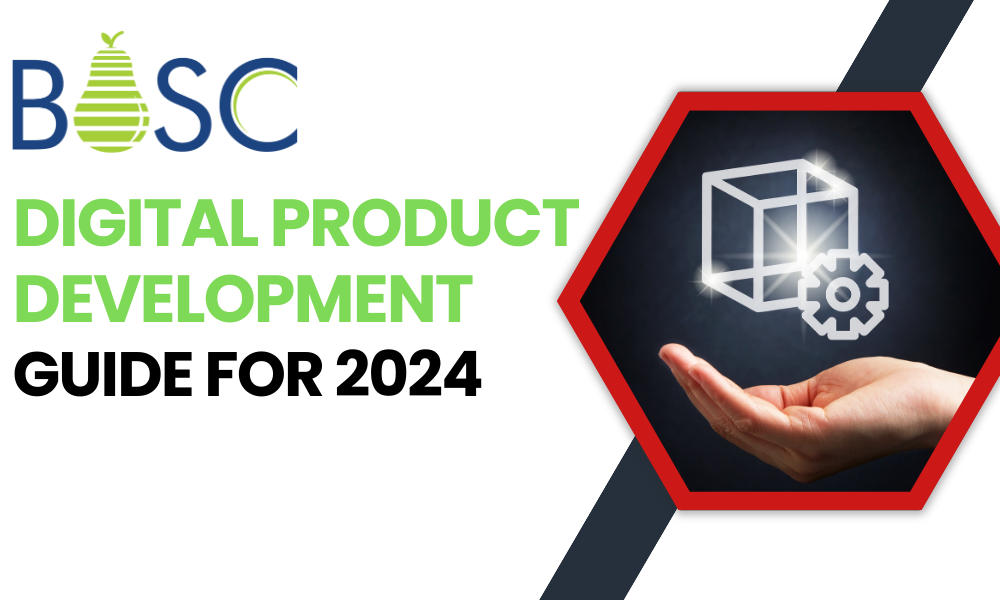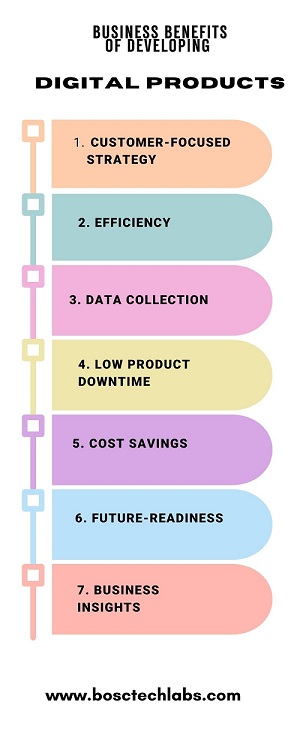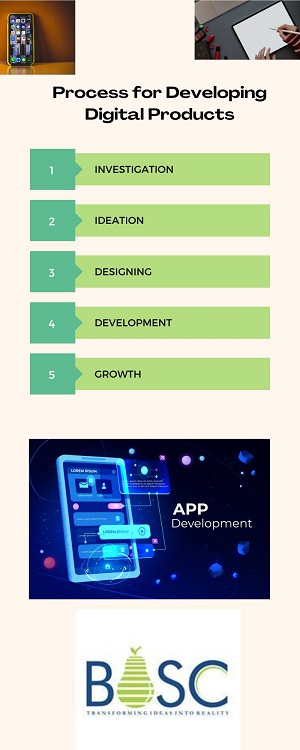
The Definitive Guide to Digital Product Development in 2024
Since they alter how organizations conduct their operations, the demand for creative digital solutions is at an all-time high in this rapidly expanding digital marketing services. They can overcome distance limitations and please their clients thanks to it. Today, practically every business focused on growth wants to innovate and enhance the utility and value of its goods.
It’s time to reconsider how a firm would approach product development if your organization isn’t utilizing digital product development or is only occasionally doing so. You would probably concur that advancing items is essential to long-term viability. And the importance of digital product creation to businesses has never been greater.
This blog is your go-to source for insights, ideas, and best practices to help you navigate the always-evolving world of digital product development, whether you’re a startup founder or an enterprise owner enthusiastic about exploring the convergence of technology and design.
So let’s start!
Introduction of Development Digital Product
Development of various digital products is a comprehensive process comprising their creation, improvement, and release. Software programs, websites, mobile apps, or digital services would all fall under this category. Creating useful and user-centric solutions would also require conceptualizing, designing, programming, testing, and deploying these products.
It offers useful and interesting experiences by merging creativity, technological know-how, and user-centric design. A talented group of experts, including product managers, designers, developers, and quality assurance testers, works together to ensure a digital product succeeds. Their combined knowledge and effort result in successful products. It entails utilizing technology, frameworks, and tools to realize ideas and iterate on them continually in response to user input and market needs.
Typically, the process begins with gathering requirements and comprehending user demands, followed by the creation of wireframes and prototypes to visualize the structure and functioning of the product. The product is then coded by development teams, which integrate features and functions while guaranteeing scalability, performance, and security. To enhance the user experience and fix problems or defects, iterative testing and improvement are carried out. The product is then launched and continually checked for upgrades and mobile app maintenance.
So why should you pursue the development of digital products in 2024?
Digital product development is being adopted more and more, but not entirely. There are several strong reasons for developing digital products in 2024. They consist of the following:
1. Rapid adjustment to shifting customer expectations: Your digital product may remain relevant by continually evolving in response to the constantly shifting market dynamics and user needs. Therefore, adopting antiquated, inefficient development methods is not an option. With digital products, you can cater to consumer demands and offer specialized solutions.
2. Get a competitive edge: you must innovate better than your rivals and be the first to provide changes that satisfy client preferences. Consequently, using modern technologies for your digital products would be beneficial.
3. Revenue Generation: In times of economic uncertainty, introducing or improving a new product can be difficult yet beneficial. Similar to how the eating, hotel, education, and retail industries have changed to suit new demands, digital solutions may help you tap into new revenue sources.
What Are the Business Benefits of Developing Digital Products?
To fully take advantage of the various benefits of creating digital products, from generating a revenue stream to establishing a strong brand, collaboration with a knowledgeable and experienced IT partner is crucial. You’ll be able to obtain a product that lives up to user expectations. The list includes,
1. Customer-focused strategy: The digital product uses cutting-edge technologies to enhance user experiences.
2. Efficiency: You have visibility at every development level, lowering workflow friction. With early decisions, it improves workflow efficiency and iterations.
3. Data collection: To facilitate future experiences, your digital product might retain crucial consumer data like payment details. In addition, it can analyze trends that might lead to the development of new income streams and store other company data.
4. Low product downtime: The digital product development process makes an early error, bug detection, and resolution possible, boosting the outcome.
5. Cost savings: You may do business more profitably by continually improving your digital offering in response to consumer feedback.
6. Future-Readiness: You create a scalable digital product that can be improved continuously in response to increasing customer needs and expectations.
7. Business insights: Data is gathered and used by the digital product to improve marketing and advertising activities. It promotes brand loyalty while assisting client attraction, providing personalized experiences, and rewarding repeat customers.
Data’s importance in the development of digital products
Data is essential to designing and developing digital products because well-informed choices lead to better user experiences, higher customer satisfaction levels, and a greater chance of product success. Data is essential for reasons such as:
1. Precise decision making:
Making data-backed decisions fast is possible across the whole lifespan of developing a digital product. The members of your IT team can build and enhance the product more effectively by considering customer demands, preferences, and behaviors.
2. User-centric strategy:
Data reveals user pain spots and aids in understanding how consumers engage with your product, what features they find useful, and how you can improve their experience. This is known as a user-centric approach.
3. Iterative development:
Digital products gather and analyze data to offer insightful information that aids teams in identifying areas for improvement. They might perform iterative modifications to improve the product and make sure it changes in response to customer input and market demands.
4. Monitoring performance:
Data enables the monitoring and measurement of the performance of your digital product. For measuring the performance of your product, you may monitor metrics like user engagement, conversion rates, and user happiness.
5. Customization:
You may adapt your digital product to each user’s particular requirements and preferences by using the data that has been gathered. By studying user data, you may customize the product experience, content, and features.
Process for Developing Digital Products
The life cycle of developing a digital product includes several phases or stages, each with several procedures or processes. They all work together to make sure your digital product is successful. Although it could change based on your circumstances, the approach below is often followed.
The following phases are involved in creating a digital product:
1. Phase 1: Investigation
It is essential to developing a digital product since it helps reduce risks and identify possible issues early on. Finding gaps and verifying the demand for a solution entails actively engaging end users. This stage assists stakeholders in determining whether their product concept is viable and stops the creation of solutions that do not meet consumer demands. By tackling user pain points from the outset, the discovery process saves time and money. It contains:
Goals and visions: Setting clear objectives for your project is crucial, as is concentrating on why something needs to be built rather than merely what has to be developed. Interviewing stakeholders and users will help you understand their requirements and expectations. Additionally, it aids in locating chances that support your objectives.
Product strategy: It’s critical to implement the vision and provide the project team guidance. The strategy is laid in a clear roadmap with specific goals, measurable standards for success and analytics, value propositions, etc.
Analysing Market: By doing competition analysis, acquiring market data, examining trends, and assessing how your product fits the market, market analysis helps product strategy match market demands and expectations.
Product analysis with user-view: Analysing your proposed product from the perspective of a specific group of consumers and determining if it offers them value is known as “user-centric product analysis.” The procedure aids in identifying certain features and functions of your product.
The Product Requirements Document (PRD) and a project roadmap are the deliverables during the discovery stage. They aid in identifying the Minimum Viable Product (MVP) and the necessary features.
Phase 2: Ideation
To create a product that satisfies client demands, you brainstorm answers to the issues discovered during the discovery stage. You can explore several solutions and find a solution fit by completely understanding the problem during discovery.
You may utilize internal brainstorming, the five-whys technique, surveys and feedback, competition analysis, the 6-3-5 method, social media listening, and more to find viable answers. To develop ideas for your digital product, these techniques draw on group cooperation, problem analysis, consumer insights, and creative thinking.
Phase 3: Designing
In this phase, you’ll design your digital product’s user interface and experience, including how it will look and what kinds of user experiences it will provide. It contains:
UX prototyping: To build a user-centered digital product, it is crucial to make a simple prototype demonstrating its functionality and good user experience. This objective is accomplished using strategies like design thinking, streamlined workflows, and tested prototypes. Usability testing allows you to get information from end users and choose the best solutions to meet their needs and preferences.
Building UI design: Wireframe development is the first step in creating the user interface. Based on user feedback, they went through additional development to become more comprehensive designs. To produce a pleasing user experience, UI design uses visual components, including pictures, color, typography, and layout. It also covers data visualization strategies that use graphs, tables, and charts to show information in a manner that is accessible.
Deliverables at the design stage of the development lifecycle for a digital product include wireframes, design assets like media, photos, and logos, and style guides like color schemes and fonts.
Phase 4: Development
Coding and programming are involved in the iterative process of creating a digital product. At this point, the product design is brought to life by the development team. Utilizing numerous technologies, such as software tools, programming languages, app development frameworks, etc., is what it includes. Utilizing industry best practices, current trends, and a talented development team are necessary for producing a dependable, effective, secure, and scalable product. Creating the necessary features and functionality to make your digital product function is also a part of this stage. They would include the following:
Software engineering: Whether creating a web, mobile, business enterprise application, system, or platform, this process entails the development team applying their knowledge and expertise to your intended digital result. To satisfy your product’s technical needs, they use a variety of technology services, including Cloud, IoT, Data Analytics, AI, ML, and others.
Testing for quality and user acceptance: The testing team runs some tests to ensure that the created product functions as intended and satisfies user needs and expectations.
The Minimum Viable Product (MVP) is deliverable in the development process. It features a user interface and essential functionality that satisfies the fundamental needs noted throughout the design phase. It is the first stage in advanced product development, powered by quicker release cycles, highlighting improvement opportunities.
Phase 5 : Testing
The app is rigorously tested to uncover and resolve any defects, focusing on its functionality, performance stability across various conditions, and compatibility with a range of devices and operating systems.
Phase 6: Growth
It’s critical to consider expansion and expanding your audience when you refine your product in response to feedback from the minimal viable product (MVP). The development team may aid in the growth and scaling of your product after its original design and development phases. The following are the steps for building digital goods during the growth stage:
Learning & Iteration: QA testing continues to be a process even after the initial market releases. At each stage, thorough documentation must be produced. The product’s users will be able to understand and use it if the documentation is completely user-friendly. Continuous testing becomes increasingly important as you keep adding new features. Certain characteristics might need to be adjusted if a step isn’t working properly. Users may ask for more features inside your product.
Therefore, continuous learning and iterating are crucial until the product is ready for its live launch.
Ongoing Development: The maturation phase begins after your digital product has been released. It involves adding new features, making updates, providing customer service, and, if necessary, using software engineering. Through this continuous development process, your digital product may grow, keep up with trends, cater to new demands, and improve user experience.
Evolution & Feedback: Feedback is essential for ensuring that your product continues to meet the needs and expectations of users. It aids in realigning the product with changing consumer demands and industry developments. Therefore, your digital product’s user experience, performance, security, quality, functionality, and other aspects might change.
Maintenance and Support: Without constant maintenance and assistance, your development procedure would be lacking. You don’t want faults or glitches to damage your product’s reputation once launched. As a result, it is crucial to start planning for this phase immediately. You must set aside resources to continuously maintain your product and ensure it remains useful.
Top factors to take into account when creating digital products
To maximize the probability of establishing a successful product that satisfies user demands provides a fantastic user experience, and maintains market competitiveness, you must consider the following elements when developing digital products.
1. Build Something You Would Use: By utilizing the product yourself, you can be sure it is worthwhile. Consider if it would be valuable to others if you wouldn’t utilize it.
2. Ensure Accessibility For All Users: It would be beneficial to consider the preferences and needs of people with impairments. Engage with them to learn about their difficulties and implement the required adjustments to increase accessibility.
3. Make a good user experience: A priority by testing your product and getting user input. It involves finding problems and improving the user experience. Maintain the beneficial qualities of your product while removing obstacles.
4. Consider Outsourcing To Experts: If your experience is limited, consider outsourcing to a business developing digital products, such as BOSC Tech Labs. They have expertise in supplying high-quality items which you can use. They can turn your idea into a useful digital creation.
5. Invest in Quality Testing: Extensive testing helps you grasp consumer preferences and demands. Utilise data to direct the development of your digital product, ensuring continued customer pleasure and relevance.
Conclusion
Digital innovation is a dynamic field that is always changing. Your company must embrace digital product development to keep up and stay in front. This strategy might encourage innovation and enhance the user experience.
Understanding the steps involved in building a digital product, how product management should be taken into account before beginning development, and the benefits it offers will help you make educated IT decisions. A good digital product should solve a problem or meet the demand of your target audience, provide a pleasant user experience, and constantly innovate to stay competitive. Connect with us now to get more details about digital product development.
Frequently Asked Questions (FAQs)
1. What is a roadmap for digital products?
A digital product roadmap is a schedule that contains a product’s goals, priorities, and development.
2. What is the definition of the digital product lifecycle?
The term “digital product lifecycle management” refers to the process of keeping a product up to date and ahead of the competition by releasing fixes and enhancements based on customer feedback, market trends, and research to make sure the product is profitable, competitive, and relevant for the duration of its lifecycle.
3. What is the definition of a digital product?
The development of software-driven user experiences that enhance, in part or entirely, the user journey of an organization is referred to as “digital product development.” Agile development approaches are often used to provide things quickly while testing and iterating frequently depending on feedback from stakeholders.
4. How much does developing a new product set you return?
The price of a startup product varies widely based on the sector, firm size, and other elements. However, The average startup product develops for between $5,000 and $10,000. These expenses may be divided into three primary groups: manufacturing, marketing, and research & development.
Start Your Product Development Today

